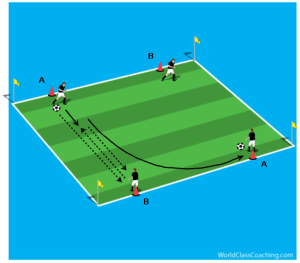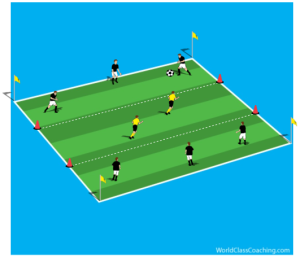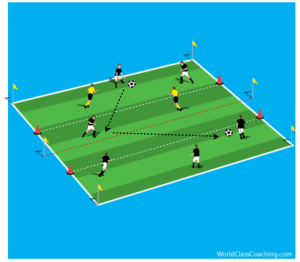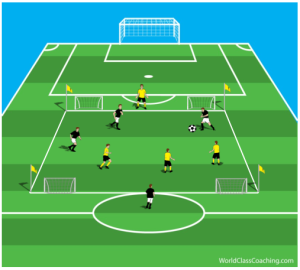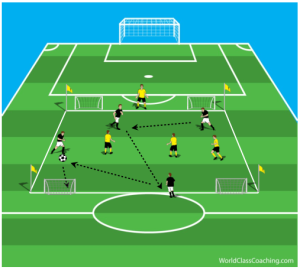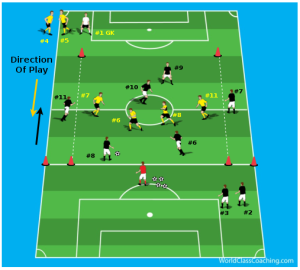When you coach young players, it can be difficult to know where to start. Some coaches will focus onlyon developing technique without teaching the key elements of the game. But this can just stunt a young player’s development. When they don’t understand the game’s core principles, they won’t know where they need to be and why so they can use their technique to create chances to score. To solve this age old problem, two experts in youth coaching have created Coaching the Principles of Soccer – Attack and Defense. This book presents a structured approach to developing an understanding of how the game is played and to provide them with a solid base on which they can develop.
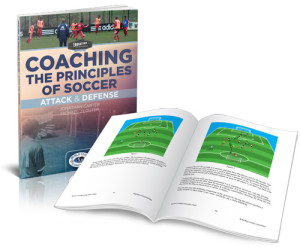
The drills in Coaching the Principles of Soccer – Attack and Defense will enable you to develop a team with a richer understanding of what to do, when to do it and why, in every phase of the game. The drills also provide a strong foundation on which you can add more technical drills and strategic play, and build players with coaching brains to match those in their feet.
Here is an session from the book that focuses on penetration in attack.
Introduction | The ‘Introduction’ of the session plan should allow the player to establish the technique required to perform & perfect the skill to be tested later in the decision-making components of the session.
Set Up
4 Player Passing Rotation
∙25yrd x 15yrd
∙Long – Short – Short & Move
∙Opposite stations work at the same time
∙Player ‘A’ passes to player ‘B’
∙Player ‘A’ follows his pass
∙Player ‘B’ plays short back to ‘A’
∙Player ‘A’ plays short back to ‘B’
∙Player ‘A’ moves to the vacated station ‘A’ on the adjacent grid
∙Repeat in reverse
Coaching Points
Technical
∙Driven ‘long’ pass
∙1st time ‘short’ pass
∙Angle of movement after exchange of passing
Tactical
∙Timing of the Pass
∙Weight of Pass
∙Verbal & Visual communication
Game Related | ‘Game Related’ means that exercises & activities need to have some relevance or connection to the game of soccer. There should be a progression into ‘Game Specific’ activities.
Set Up
3 Zone Penetration Passing
∙20yrd x 30yrd
∙Grid split into three equal zones
∙3 Black Attackers in either end zone | 2 Yellow Defenders in the middle zone
∙All players conditioned to remain within their allocated zone
∙Black Attackers have to create a penetrating pass through the middle zone – must be received by the other Black
Attackers
∙Points scored for successful penetrating passes
∙Points scored for Yellow Defenders intercepting
∙Rotate roles regularly
Coaching Points
Technical
∙Positive | Open body shape
∙Preparation look forward
∙Mobility
Tactical
∙Timing of the Pass
∙Weight of Pass
∙Verbal & Visual communication
Progression | ‘Progressive’ means that as the session develops the degree of pressure the player is subjected to and the level of difficulty of the required task should increase – thus ‘Progressive’
Set Up
3 Zone Penetration Passing + Defender
∙Allow 1 Yellow Defender to enter the Black Attacking zone
∙Allow 2 Yellow Defenders to enter the Black Attacking zone
∙Introduce a 3rd Yellow Defender
∙Allow 1 Yellow Defender to remain conditioned to each Black Attacking zone
∙Allow 1 Black Attacker to enter the middle zone to provide additional support ahead of the ball
Coaching Points
Technical
∙Positive | Open body shape
∙Preparation look forward
∙Mobility
Tactical
∙Timing of the Pass
∙Weight of Pass
∙Verbal & Visual communication
Game Specific | ‘Game Specific’ means that exercises & activities have a recognisable connection to real soccer i.e. opposing teams, team-mates, decision-making requirements, directional play, territorial invasion, goals/targets & transition of possession etc.
Set Up
4 vs. 4 To Switch Goal | High Anchored Forward
∙30yrd x 30yrd
∙Switch goals – Team can score in either of their two attacking goals
∙4 Black vs. 4 Yellow
∙1 ‘High-Anchored’ forward for each team is conditioned behind the opposition goal line – this player can support the play but cannot score
∙Attacking team must play through the ‘High-Anchored’ forward in each attacking phase
∙Rotate roles regularly
Coaching Points
Technical
∙Driven ‘long’ pass
∙1st time ‘short’ pass
∙Angle of movement after exchange of passing
Tactical
∙Timing of the Pass
∙Weight of Pass
∙Verbal & Visual communication
Conditioned | ‘Conditions’ can be imposed on the players or on the playing environment to encourage specific soccer behaviour relevant to the session theme.
Set Up
4 vs. 4 To Switch Goal | High Anchored Forward
∙30yrd x 30yrd
∙Allow the ‘High-Anchored’ forward for each team to now enter the field-of-play
∙Allow the ‘High-Anchored’ forward for each team to score goals
∙Remove the condition that each attacking phase must play through the ‘High-Anchored’ forward
∙Play with an offside rule
Coaching Points
Technical
∙Driven ‘long’ pass
∙1st time ‘short’ pass
∙Angle of movement after exchange of passing
Tactical
∙Timing of the Pass
∙Weight of Pass
∙Verbal & Visual communication
6 vs. 4 in Midfield Third | 6 Black Attackers vs. 4 Yellow Defenders
∙Black Attackers #6,7,8,9,10 & 11 vs. Yellow Defenders #6,7,8 & 11
∙Progression > Black Attackers #2 & 3 vs. Yellow Defenders #1GK,4 & 5
∙Ball restarts from the Red feeder into Black Attackers
∙Black Attackers try to play the ball forward through any of the three attacking small gates
∙If Yellow Defenders regain possession they try to play the ball forward through opposite small gates
Phase of Play #2
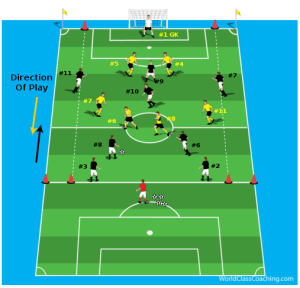
8 vs. 6 + GK in Midfield Third to Goal | 8 Black Attackers vs. 6 Yellow Defenders + GK
∙Black Attackers #6,7,8,9,10 & 11 + #2 & 3
vs. Yellow Defenders #6,7,8 & 11+ #1GK,4 & 5
∙Ball restarts from the Red feeder into Black Attackers
∙Black Attackers play to Yellow goal & GK
∙If Yellow Defenders regain possession they try to play the ball forward through opposite small gates
∙Offside conditions apply
[wpsharely id="6889"] [/wpsharely]Click here to learn more about Coaching the Principles of Soccer - Attack and Defense.
Have a great day!
Tom

